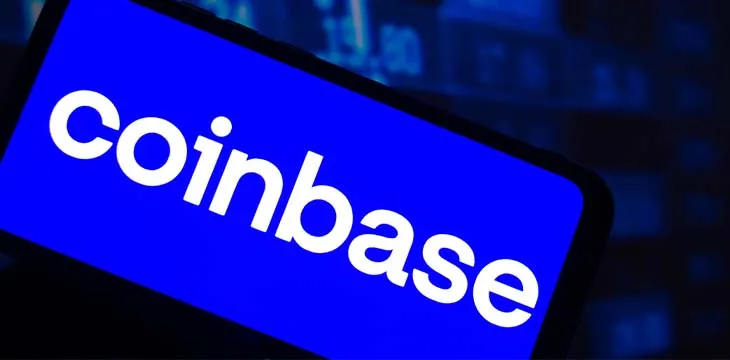|
Getting your Trinity Audio player ready...
|
Coinbase’s (NASDAQ: COIN) year-to-date losses now total $2.1 billion as retail traders grow tired of going broke on America’s largest digital currency exchange.
Figures released on November 3, show Coinbase generated revenue of $590.3 million in the three months ending September 30, a 55% decline from the same period last year. Despite a double-digit reduction in operating expenses, the company booked a net loss of $556.5 million compared to a nearly $292 million profit in Q3 2021.
The net loss is only half the $1.1 billion in red ink Coinbase reported in Q2, but worse than Q1’s $430 million loss. For the year-to-date, Coinbase has tossed nearly $2.1 billion on the bonfire, a far cry from the nearly $2.8 billion profit Coinbase had booked at this point last year.
As further evidence of how topsy-turvy the ‘crypto’ sector is, losing another half-a-billion-plus is apparently what qualifies as a “mixed quarter” at Coinbase. The mix is thus: the subscription and services segment performed okay, while transaction volume and revenue fell off a cliff.
Transaction revenue fell 44% from Q2, for which Coinbase blamed macroeconomic headwinds and “trading volume moving offshore.” Retail transaction revenue totaled $346.1 million (-66% year-on-year, -44% from Q2) while institutional transaction revenue fell to just $19.8 million (-71% year-on-year, -50% from Q2).
Total subscription and services revenue rose 43% from Q2 to $210.5 million despite declines in the Blockchain rewards segment ($62.8 million, -8%) and custodial fee revenue ($15 million, -34%). Ironically, the same economic headwinds that Coinbase blamed for its transaction woes spared it from an even greater embarrassing quarterly result.
The lone bright spot on Coinbase’s subscription and services chart was interest income, which shot up 213% to $101.8 million thanks in large part to the U.S. Federal Reserve hiking its lending rates. Those high rates benefit Coinbase via its holdings of the USDC stablecoin, which was developed by both Circle and Coinbase via the Centre consortium in 2018.
Coinbase shares closed Thursday down 8% to $55.80 but rose around 5% in after-hours trading and closed Friday just shy of $59. But that’s still a fraction of the $232 the shares were worth when the year began.
Blood from broke-ass stones
The reduction in Coinbase’s retail business was reflected in the ‘customer custodial cash’ item on its asset sheet, which fell from $10.5 billion at the end of 2021 to just $6.6 billion in the most recent quarter. Simply put, this spring’s crypto crash and the resulting ‘crypto winter’—coupled with the demise of federal easy-money pandemic-relief programs—means there’s currently zero enthusiasm at the retail level for throwing good fiat after bad shitcoins.
The retail chill was also evident in the minnows’ trading volume falling 72% year-on-year to $26 billion. Institutional trading volume fell a more modest 43% to $133 billion. While some of this decline has to do with sharp declines in the fiat value of most digital assets, it’s clear that Coinbase is in for a world of hurt if Jerome Powell abruptly reverses course on the Fed’s fight against inflation.
Coinbase’s ‘verified users’ rose by nearly one-half year-on-year to 108 million, although ‘monthly transacting users’ (MTU) rose a more modest 16% to 8.5 million. Worse, those MTUs fell 6% from Q2—and keep in mind that ‘transactions’ include fiat withdrawals—although Coinbase claimed this was the result of users shifting “from trading to non-trading transactions,” like staking and yield-bearing products.
The call (of Brian’s bluff)
On the earnings call, CEO Brian Armstrong felt it necessary to state that “we can’t actually predict the future,” in case anyone had just watched his new self-reverential documentary and concluded that he possessed some alien oracle abilities. Nonetheless, Brian donned his soothsayer hat and declared that “the spring is coiling” and “there’s a lot of people preparing for when the next upswings happen.” There are also preppers digging fallout shelters, but forget those killjoys for the moment.
Whistling furiously past this graveyard, Armstrong recalled how many boom-and-bust cycles Coinbase has weathered in its 10-year history and claimed that “I actually enjoyed the down cycles a little bit more.” You see, in boom times, “a lot of people rush into crypto for sometimes the wrong reasons,” while “true believer” types are the ones who stick around during the busts. (Hear that, retail traders who stopped buying cuz you’re broke? You suck!)
Advance knowledge of the Q3 carnage likely contributed to the recent announcement by Coinbase’s chief product officer Surojit Chatterjee that he was stepping down after three years. His exit was announced as part of a company reorganization that will lump its product, engineering and design teams “within a product group structure under which the leaders of such groups will assume responsibility for Coinbase’s product offerings.”
All these group leaders will report to Armstrong, who said last week that he wanted to give them “the ability to move quickly and nimbly pushing down decision making in the org, having them operate a little bit like three different start-ups within our larger company.”
God bless America, unless someone is drinking our milkshake
Asked about Coinbase’s claim that traders are moving ‘offshore’ to exchanges like Binance that have rolled out zero-fee BTC transactions, chief operating officer Emilie Choi clarified that “companies that say zero fee are still generating a spread” and Coinbase was “not going to compete on price because of the premium nature of our offering.”
Exchanges based in less, er, rigorous regulatory climates also get to offer products that Coinbase can’t legally provide. Armstrong said he repeatedly told policy makers that “by pushing so hard on local companies, you’re not actually protecting investors. You’re just encouraging them to move offshore to even less regulated options, right?”
Armstrong went as far as to question the wisdom of Coinbase remaining a U.S.-based company because “the U.S. doesn’t always act as quickly or nimbly” as other nations on regulatory issues. Armstrong feels Coinbase is “facing unnecessary headwinds” based on the company’s (alleged) commitment to compliance.
Armstrong claimed this commitment to working within regulatory boundaries wasn’t restricted to the U.S. of A, as “we’re taking a very trusted and compliant approach globally” and aren’t trying “to cut new corners or move too fast.” Yeah, about that…
Coinbase recently joined a new industry body aimed at convincing India’s government that crypto isn’t the last bastion of financial scoundrels. The Bharat Web3 Association (BWA) is intended to replace the Blockchain and Crypto Assets Council (BCAC), which folded its tents in July after its parent group, the Internet and Mobile Association of India, decided that further association with crypto was a reputational sinkhole.
A few months before the BCAC’s demise, Coinbase jumped the gun by launching an Indian-facing operation that encouraged the use of the country’s popular Unified Payments Interface. Typically, Coinbase had taken this step without government approval, leading to an embarrassing suspension of operations at its Indian-facing site. But, you know, “we’re trying to do the right thing for the long term, even if it’s more difficult in the short term.”
USDC what I did there?
Interest income from Coinbase’s USDC helped blunt its Q3 losses and, in the near term, Coinbase appears to be banking future growth on its close USDC ties. Last month, the MakerDAO community okayed a plan for Coinbase to custody up to $1.6 billion in USDC in exchange for paying community members a 1.5% reward.
Around the same time, Coinbase announced that USDC adoption was lagging outside the U.S., prompting the exchange to allow European customers to buy USDC directly with euros or pounds without first converting to USD. On Thursday, Armstrong predicted that USDC “will probably end up being kind of like a de facto central bank digital currency for the U.S.” due to its “applicability across many different customer segments.”
Coinbase’s announcement this summer that it was “unifying’ its USD and USDC order books was ostensibly taken due to Coinbase’s faith in USDC providing a “more seamless trading experience,” but the news sparked concerns that a lack of retail deposits had left the exchange in a liquidity crunch.
The uncomfortably close ties between the largest stablecoin by market cap (Tether) and its sister exchange Bitfinex have never sat right with regulators but those companies don’t call America home. Armstrong would do well to remember how the powers that be reacted when Mark Zuckerberg tried to supplant USD with his Diem/Libra digital currency.
How to lose friends and influence nobody
Not content with simply burning money, Coinbase appears intent on burning what’s left of its reputation with the U.S. Securities and Exchange Commission. Coinbase recently sought federal court approval to file an amicus brief in support of Ripple Labs’ fight with the SEC over the latter’s view that the XRP token is an unregistered security.
On Halloween, Coinbase’s chief legal officer Paul Grewal announced that Coinbase’s brief centered on the SEC’s lack of “critical fair notice” to Ripple Labs that they were breaking the law before filing suit against them. This wouldn’t be the first time that a C-suite Coinbase exec had misread the law but it’s always disconcerting when it’s the company’s supposed legal expert.
Coinbase’s support for Ripple is also intended to bolster its own legal cause. In July, the SEC declared that “at least nine” tokens involved in a Coinbase insider trading case were unregistered securities. Reuters later reported that the SEC was probing Coinbase regarding its decisions to list numerous tokens that the SEC feels meet the Howey Test that defines securities.
If his unintentionally hilarious documentary didn’t make it obvious, Brian sees himself as an unquestioned force for good in this crazy world. The man who bought a $133 million house after dumping some of his Coinbase shares (onto investors who went on to book huge losses) and encouraged credulous retail investors to buy in at the top of the market (who went on to book huge losses) truly believes “our mission has increased economic freedom for the world.” Freedom from worrying about money they no longer have, at least.
Follow CoinGeek’s Crypto Crime Cartel series, which delves into the stream of groups—a from BitMEX to Binance, Bitcoin.com, Blockstream, ShapeShift, Coinbase, Ripple,
Ethereum, FTX and Tether—who have co-opted the digital asset revolution and turned the industry into a minefield for naïve (and even experienced) players in the market.

 07-09-2025
07-09-2025 





